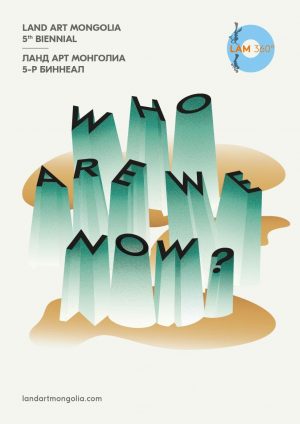WHO ARE WE NOW ?
5th Land Art Mongolia
July 30th – August 25th 2018
Curator: Lewis Biggs
Globalisation can be understood specifically as an attack on cultures that are close to ‘nature’, or that continue to respect the values implicit in ‘nature’. What are these values? The attitude that humanity shares a delicately balanced habitat with other animals, and that the entire ecology deserves our respect. It is a holistic outlook, advocating sustainable rather than exploitative approaches to resources. This attitude, these ‘natural’ values, were present in early Humanism. What went wrong?
The balance between city-dwellers and rural populations tipped in the direction of urbanism. More of the world’s population is resident in cities than in the countryside, and this process continues to accelerate. It means that fewer and fewer people understand or value the complex and dynamic ecology of ‘nature’ as a set of values or a philosophical model. But urbanisation is only evidence of a more massive change both in the history of ‘humanity’ and in the history of ‘nature’.
The narrative that describes the development of the natural world is the science of geology, since what we know about the long history of the planet has been mapped mainly through geology. There is now a decisive body of evidence to show that the surface of the planet entered a new geological age around 1950, in the decade following the detonation of the first atomic bomb. This evidence comes from many sources: from records of radioactivity, of the use of fossil fuels, of pollutants, of atmospheric and climatic changes, and of the rate of extinctions of species of plants and animals.
The name given to this new age is the Anthropocene, from ‘anthropos’, the Greek word for human. We’ve entered the Age of Humanity, when the behaviour of humanity has become the dominant factor in the ecological balance of the planet.
How do we situate art, and specifically art made in the Mongolian context, in relation to Humanism and the Anthropocene Age? The idea of a trans-cultural, or trans-national, or inter-national art is a Humanist legacy. Without a belief in the commonality of human beings, it would not be possible to make art that communicates beyond one culture by appealing to that which is shared by all humans. If we deny the legacy of Humanism, it means that whatever art we make will only ever be understood or appreciated by people from our own culture.
On the other hand, the Humanist legacy must be held responsible (along with militarism, empirebuilding, commercial greed and financial power) for producing globalisation and the Anthropocene Age. And these forces threaten each of the specific and unique geographic and linguistic cultures that have evolved over millennia, and that we value and recognise in different parts of the world.
We are interested to open a discussion on human values today that will be shared in one of the most remote areas on the globe for a display at the Biennial venues of the capital Ulaanbaatar to enhance a mutual exchange on these issues.
CALL FOR PROPOSALS
We seek applications from emerging and mid-career artists, experience in environmental art is requested. The program is designed to pursue personal creative work and share in collegial interaction within a small community of Mongolian and international artists.
During the Biennial production invited artists are accommodated in traditional gers located in a rural mountains setting and nomadic family neighbours, about 5 km away of a little village Murun Sum and about 4 hours from the capital Ulaanbaatar.
The professional ger camp provides bathroom and shower, kitchen, and studio. Artists are expected to interact with the environment of the nature. (installation, performance, earth art, concept, etc.)
A documentary exhibition of the realized works will be presented at the Biennial venues of Ulaanbaatar. The exhibition will be completed by a publication and a one-day symposium in the Academy of Science.
Artists presence in Mongolia: July 30- August 11th 2018 – Biennial LAM 360° open for the general public admission free from August 11. – 25. 2018
Eligibility:
National and International visual artists are eligible to apply. Please note the application, resume and all support materials must be in English. Students are not eligible for residencies. Accommodations will be provided to selected individual artists only.
Requirements for proposal:
Interested artists are asked to submit applications via email to: office@landartmongolia.com
Please make sure you include the following information in your application:
– Personal information, contact address, email – Artistic proposal, work plan
– Documentation of prior works, up to 10 jpgs (no more than 1MB each)
– CV / artist statement
– The submission shall be entitled as: surname_name.PDF
Your submission packet must consist of one single PDF. Please note that incomplete applications and applications consisting of more than one file cannot be considered.
Regulations:
Invited artists will be hosted during their stay in Mongolia. LAM 360° will provide transportation within Mongolia and full accommodation during the stay in Khentii Aimag and Ulaanbaatar July 30- August 11th 2018. Due to the limited resources in the steppe only individual proposals are accepted. Deadline for submissions is January 30th 2018. Curatorial decisions are
expected by February 2018.
Please note that only shortlisted artists will be notified.


